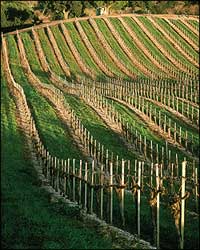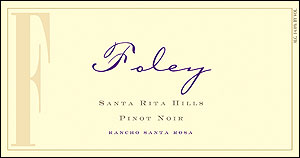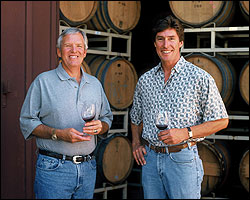Friends and colleagues gathered recently at Santa Barbara County's La Purisima Mission to honor Richard Sanford, and I couldn't help but wonder what took them so long.
Sanford, if not a winemaking legend, is at least the next best thing. He was way ahead of his time when he rounded up investors and started a winery outside of Buellton in 1969.
 Buellton is a small California crossroads about 50 miles northwest of Santa Barbara, in the heart of the Santa Ynez Valley. In the late 1960s, grape growers were selling their crop each harvest to the wineries of northern California, and hardly anyone outside of a small circle of wine industry folks would have thought of the region as wine country.
Buellton is a small California crossroads about 50 miles northwest of Santa Barbara, in the heart of the Santa Ynez Valley. In the late 1960s, grape growers were selling their crop each harvest to the wineries of northern California, and hardly anyone outside of a small circle of wine industry folks would have thought of the region as wine country.
The cash crops then were Cabernet Sauvignon and Chardonnay, and the vineyards were mostly located in the warmer part of the Santa Ynez Valley east of Highway 101. But Sanford had a different idea.
"I had been given a bottle of red Burgundy while I was in the Navy," he recalled. "It was a Pommard and it was wonderful. And at that moment I fell in love with Pinot Noir."
Sanford did his homework and came to the conclusion Pinot Noir required a cool climate for optimal results.
"Pinot Noir from warm areas seemed heavy to me," he said. "I didn't like that. I came here 35 years ago to plant Pinot Noir for reasons of climate only."
Following his release from the Navy, he thus focused his attention on the western Santa Ynez Valley, an east-west valley that is open to the sea and the cooling breezes that blow off of it. He studied the temperature gradations from Lompoc, very near the Pacific Ocean, to Buellton, about 20 miles inland.
"I must have been an amusing sight," he remembered. "Driving up and down the highway between Lompoc and Buellton with my thermometer hanging out the window as I took the temperature readings."
He finally settled on a site west of Buellton that became the Sanford & Benedict Vineyard, precursor to the Sanford Winery. Sanford's Pinot Noirs won acclaim early on, and other vintners were always eager to purchase grapes from the Sanford & Benedict Vineyard for their own Pinots.
Surprisingly, however, there was hardly a stampede to the other side of Highway 101. Babcock was the notable exception as most of the vineyard development and Pinot Noir planting that followed took place to the north, in another east-west trough called the Santa Maria Valley, and along both sides of Highway 101 north of Buellton on the way to Santa Maria.
Twenty years passed and still there was very little in the way of company for Sanford and Babcock in what they now call the Santa Rita Hills (recently accorded status as an American Viticultural Area, and one of the most exciting developments in California wine).
 Then Kathy Joseph went in with 100 acres to expand her increasingly popular Fiddlehead brand. Then Foley Estates. Along came Santa Barbara Winery with its Lafond brand. Then Melville and Clos Pepe. Seasmoke. Fess Parker developed a vineyard, too.
Then Kathy Joseph went in with 100 acres to expand her increasingly popular Fiddlehead brand. Then Foley Estates. Along came Santa Barbara Winery with its Lafond brand. Then Melville and Clos Pepe. Seasmoke. Fess Parker developed a vineyard, too.
"Ten years ago, none of us were here except Richard," said winemaker Alan Phillips of Foley Estates. "He gave us something to bet on. And it was a bet."
 "As Phillips spoke, a cold, biting breeze whipped through the valley as if to make his point. The Santa Rita Hills are cold. They are often covered with fog. The combination of climate and soil and terrain conspire to keep yields low regardless of the intentions of the grape grower, making for long hang time and concentrated flavors. The cool days and nights produce grapes with bright acidity, even when they are fully ripe.
"As Phillips spoke, a cold, biting breeze whipped through the valley as if to make his point. The Santa Rita Hills are cold. They are often covered with fog. The combination of climate and soil and terrain conspire to keep yields low regardless of the intentions of the grape grower, making for long hang time and concentrated flavors. The cool days and nights produce grapes with bright acidity, even when they are fully ripe.
The modern vintner is equipped, however, to confront challenging conditions and prevail. The huge gamble that many took when they eventually followed Sanford into the Santa Rita Hills has paid off in dynamic wines that have stolen much of the buzz from more established Pinot Noir regions in northern California and Oregon.
The Santa Rita Hills also produce beautiful Chardonnays, and Syrahs so intense and sweet the fruit tastes as though it had been crushed mere minutes before serving.
All of the good things now flowing from the Santa Rita Hills can be traced back to a young, naïve ex-Navy guy with a thermometer and a vision.
Lest anyone think Richard Sanford is resting on his laurels and basking in the adulation of his fellow vintners, know this: Sanford has recently parted with the Sanford Winery and started anew with a project called Alma Rosa.
The thing you will notice immediately about Alma Rosa is the twist-off cap.
"I've really gotten tired of corked wines," he says matter-of-factly.
Don't laugh. Let's see what they're doing with high-class wines 35 years from now. Sanford may well be ahead of his time, as usual.